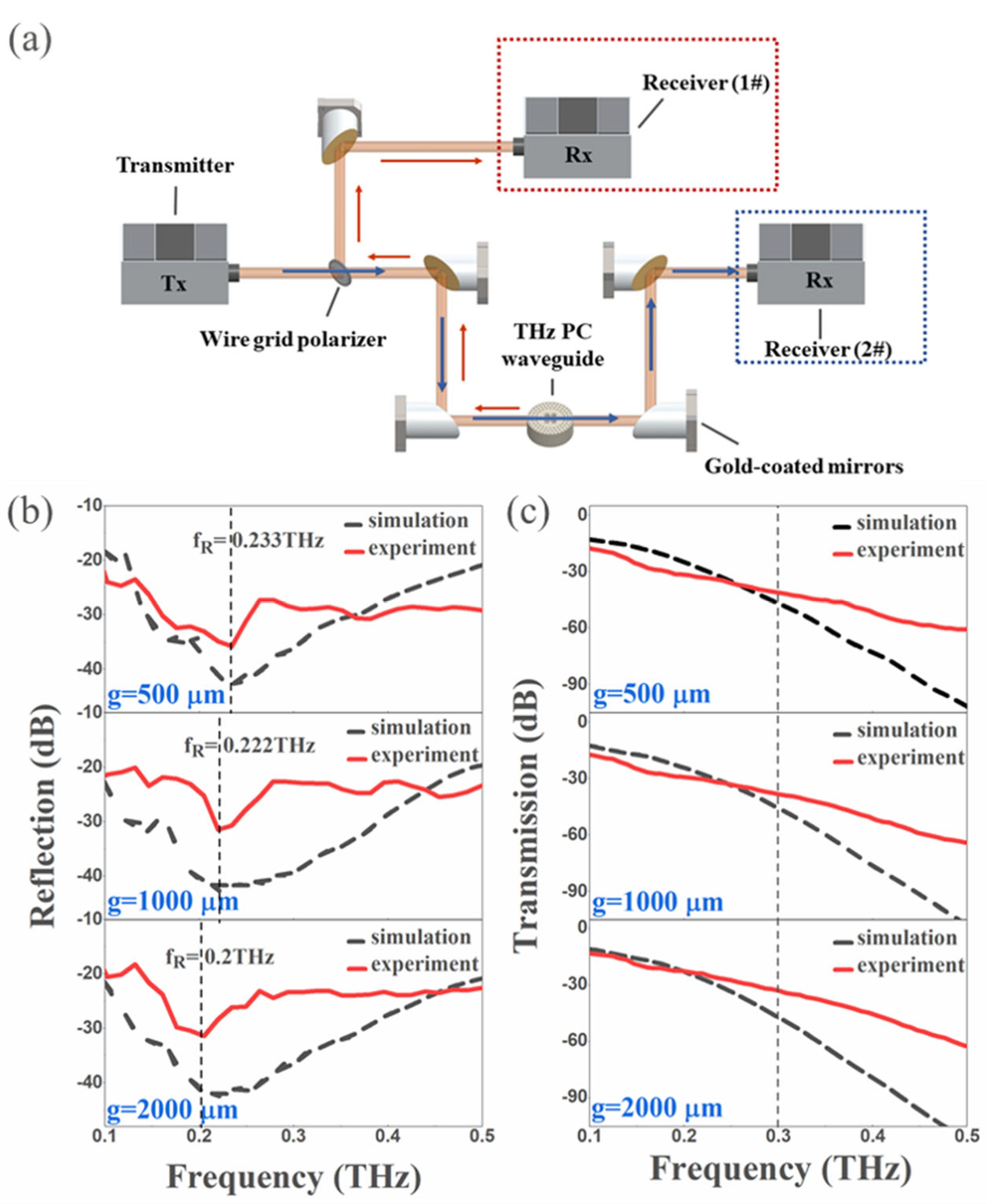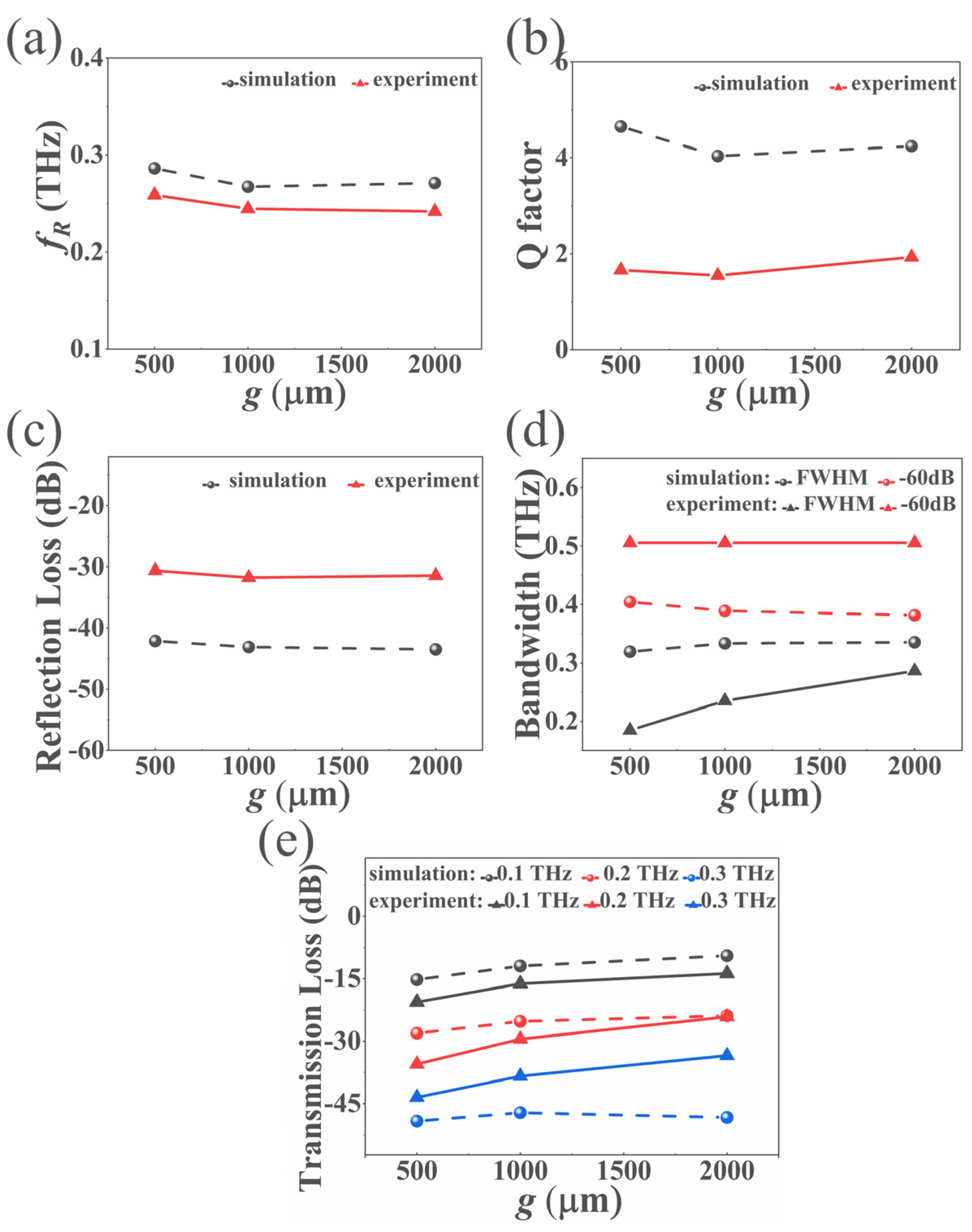Low-Frequency Terahertz Photonic Crystal Waveguide with a Lilac-Shaped Defect Based on Stereolithography 3D Printing
Abstract
:1. Introduction
2. Design and Simulations
3. Experiment and Results
3.1. Fabrication of the Proposed Waveguides
3.2. 3D Printing Based on Stereolithography
3.3. THZ-TDS Setup
3.4. Measurement and Discussion
4. Conclusions
Author Contributions
Funding
Institutional Review Board Statement
Informed Consent Statement
Data Availability Statement
Conflicts of Interest
References
- Talataisong, W.; Gorecki, J.; van Putten, L.D.; Ismaeel, R.; Williamson, J.; Addinall, K.; Schwendemann, D.; Beresna, M.; Apostolopoulos, V.; Brambilla, G. Hollow-core antiresonant terahertz fiber-based TOPAS extruded from a 3D printer using a metal 3D printed nozzle. Photonics Res. 2021, 9, 1513. [Google Scholar] [CrossRef]
- Yudasari, N.; Anthony, J.; Leonhardt, R. Terahertz pulse propagation in 3D-printed waveguide with metal wires component. Opt. Express 2014, 22, 26042–26054. [Google Scholar] [CrossRef] [PubMed]
- Lu, Y.; Feng, X.; Wang, Q.; Zhang, X.; Fang, M.; Sha, W.E.I.; Huang, Z.; Xu, Q.; Niu, L.; Chen, X.; et al. Integrated Terahertz Generator-Manipulators Using Epsilon-near-Zero-Hybrid Nonlinear Metasurfaces. Nano Lett. 2021, 21, 7699–7707. [Google Scholar] [CrossRef] [PubMed]
- Li, J.; Zheng, C.; Li, J.; Wang, G.; Liu, J.; Yue, Z.; Hao, X.; Yang, Y.; Li, F.; Tang, T.; et al. Terahertz wavefront shaping with multi-channel polarization conversion based on all-dielectric metasurface. Photonics Res. 2021, 9, 1939. [Google Scholar] [CrossRef]
- Lee, Y.S.; Choi, H.; Kim, B.; Kang, C.; Maeng, I.; Oh, S.J.; Kim, S.; Oh, K. Low-Loss Polytetrafluoroethylene Hexagonal Porous Fiber for Terahertz Pulse Transmission in the 6G Mobile Communication Window. IEEE Trans. Microw. Theory Tech. 2021, 69, 4623–4630. [Google Scholar] [CrossRef]
- Gu, T.; Andryieuski, A.; Hao, Y.; Li, Y.; Hone, J.; Wong, C.W.; Lavrinenko, A.; Low, T.; Heinz, T.F. Photonic and Plasmonic Guided Modes in Graphene–Silicon Photonic Crystals. ACS Photonics 2015, 2, 1552–1558. [Google Scholar] [CrossRef]
- Han, S.; Cong, L.; Srivastava, Y.K.; Qiang, B.; Rybin, M.V.; Kumar, A.; Jain, R.; Lim, W.X.; Achanta, V.G.; Prabhu, S.S.; et al. All-Dielectric Active Terahertz Photonics Driven by Bound States in the Continuum. Adv. Mater. 2019, 31, e1901921. [Google Scholar] [CrossRef]
- Lan, C.; Ma, H.; Wang, M.; Gao, Z.; Liu, K.; Bi, K.; Zhou, J.; Xin, X. Highly Efficient Active All-Dielectric Metasurfaces Based on Hybrid Structures Integrated with Phase-Change Materials: From Terahertz to Optical Ranges. ACS Appl. Mater. Interfaces 2019, 11, 14229–14238. [Google Scholar] [CrossRef]
- Withayachumnankul, W.; Fujita, M.; Nagatsuma, T. Integrated Silicon Photonic Crystals Toward Terahertz Communications. Adv. Opt. Mater. 2018, 6, 1800401. [Google Scholar] [CrossRef] [Green Version]
- Yokoo, A.; Takiguchi, M.; Birowosuto, M.D.; Tateno, K.; Zhang, G.; Kuramochi, E.; Shinya, A.; Taniyama, H.; Notomi, M. Subwavelength Nanowire Lasers on a Silicon Photonic Crystal Operating at Telecom Wavelengths. ACS Photonics 2017, 4, 355–362. [Google Scholar] [CrossRef]
- Reinhard, B.; Torosyan, G.; Beigang, R. Band structure of terahertz metallic photonic crystals with high metal filling factor. Appl. Phys. Lett. 2008, 92, 201107. [Google Scholar] [CrossRef]
- Su, X.; Xu, Q.; Lu, Y.; Zhang, Z.; Xu, Y.; Zhang, X.; Li, Y.; Ouyang, C.; Deng, F.; Liu, Y.; et al. Gradient Index Devices for Terahertz Spoof Surface Plasmon Polaritons. ACS Photonics 2020, 7, 3305–3312. [Google Scholar] [CrossRef]
- Yang, J.; Zhao, J.; Gong, C.; Tian, H.; Sun, L.; Chen, P.; Lin, L.; Liu, W. 3D printed low-loss THz waveguide based on Kagome photonic crystal structure. Opt. Express 2016, 24, 22454–22460. [Google Scholar] [CrossRef] [PubMed]
- Cheben, P.; Halir, R.; Schmid, J.H.; Atwater, H.A.; Smith, D.R. Subwavelength integrated photonics. Nature 2018, 560, 565–572. [Google Scholar] [CrossRef] [PubMed]
- Lin, Y.; Yao, H.; Ju, X.; Chen, Y.; Zhong, S.; Wang, X. Free-standing double-layer terahertz band-pass filters fabricated by femtosecond laser micro-machining. Opt. Express 2017, 25, 25125–25134. [Google Scholar] [CrossRef] [PubMed]
- Headland, D.; Yu, X.; Fujita, M.; Nagatsuma, T. Near-field out-of-plane coupling between terahertz photonic crystal waveguides. Optica 2019, 6, 1002–1011. [Google Scholar] [CrossRef]
- Yee, C.; Jukam, N.; Sherwin, M. Transmission of single mode ultrathin terahertz photonic crystal slabs. Appl. Phys. Lett. 2007, 91, 194104. [Google Scholar] [CrossRef]
- Fan, K.; Xu, X.; Gu, Y.; Dai, Z.; Cheng, X.; Zhou, J.; Jiang, Y.; Fan, T.; Xu, J. Organic DAST Single Crystal Meta-Cavity Resonances at Terahertz Frequencies. ACS Photonics 2019, 6, 1674–1680. [Google Scholar] [CrossRef]
- Gangnaik, A.S.; Georgiev, Y.M.; Holmes, J.D. New Generation Electron Beam Resists: A Review. Chem. Mater. 2017, 29, 1898–1917. [Google Scholar] [CrossRef]
- Huang, Y.; Zhao, Q.; Kalyoncu, S.K.; Torun, R.; Lu, Y.; Capolino, F.; Boyraz, O. Phase-gradient gap-plasmon metasurface based blazed grating for real time dispersive imaging. Appl. Phys. Lett. 2014, 104, 161106. [Google Scholar] [CrossRef] [Green Version]
- Paniagua-Dominguez, R.; Yu, Y.F.; Khaidarov, E.; Choi, S.; Leong, V.; Bakker, R.M.; Liang, X.; Fu, Y.H.; Valuckas, V.; Krivitsky, L.A.; et al. A Metalens with a Near-Unity Numerical Aperture. Nano Lett. 2018, 18, 2124–2132. [Google Scholar] [CrossRef] [PubMed] [Green Version]
- Liu, D.; Zhao, S.; You, B.; Jhuo, S.S.; Lu, J.Y.; Chou, S.; Hattori, T. Tuning transmission properties of 3D printed metal rod arrays by breaking the structural symmetry. Opt. Express 2021, 29, 538–551. [Google Scholar] [CrossRef] [PubMed]
- Ju, X.; Yang, W.; Gao, S.; Li, Q. Direct Writing of Microfluidic Three-Dimensional Photonic Crystal Structures for Terahertz Technology Applications. ACS Appl. Mater. Interfaces 2019, 11, 41611–41616. [Google Scholar] [CrossRef] [PubMed]
- Liu, X.; Tao, J.; Liu, J.; Xu, X.; Zhang, J.; Huang, Y.; Chen, Y.; Zhang, J.; Deng, D.Y.B.; Gou, M.; et al. 3D Printing Enabled Customization of Functional Microgels. ACS Appl. Mater. Interfaces 2019, 11, 12209–12215. [Google Scholar] [CrossRef] [PubMed]
- Ruiz, A.J.; Garg, S.; Streeter, S.S.; Giallorenzi, M.K.; LaRochelle, E.P.M.; Samkoe, K.S.; Pogue, B.W. 3D printing fluorescent material with tunable optical properties. Sci. Rep. 2021, 11, 17135. [Google Scholar] [CrossRef]
- Wang, R.; Yang, W.; Gao, S.; Ju, X.; Zhu, P.; Li, B.; Li, Q. Direct-writing of vanadium dioxide/polydimethylsiloxane three-dimensional photonic crystals with thermally tunable terahertz properties. J. Mater. Chem. C 2019, 7, 8185–8191. [Google Scholar] [CrossRef]
- Yan, D.; Meng, M.; Li, J.; Wang, Y. Proposal for a symmetrical petal core terahertz waveguide for terahertz wave guidance. J. Phys. D Appl. Phys. 2020, 53, 275101. [Google Scholar] [CrossRef]
- Yan, D.; Meng, M.; Li, J.; Wang, Y. Terahertz wave refractive index sensor based on a sunflower-type photonic crystal. Laser Phys. 2020, 30, 066206. [Google Scholar] [CrossRef]
- Ye, L.; Zhang, W.; Ofori-Okai, B.K.; Li, W.; Zhuo, J.; Cai, G.; Liu, Q.H. Super Subwavelength Guiding and Rejecting of Terahertz Spoof SPPs Enabled by Planar Plasmonic Waveguides and Notch Filters Based on Spiral-Shaped Units. J. Lightwave Technol. 2018, 36, 4988–4994. [Google Scholar] [CrossRef]
- Sultana, J.; Islam, M.S.; Cordeiro, C.M.B.; Habib, M.S.; Dinovitser, A.; Kaushik, M.; Ng, B.W.H.; Ebendorff-Heidepriem, H.; Abbott, D. Hollow Core Inhibited Coupled Antiresonant Terahertz Fiber: A Numerical and Experimental Study. IEEE Trans. Terahertz Sci. Technol. 2021, 11, 245–260. [Google Scholar] [CrossRef]





Publisher’s Note: MDPI stays neutral with regard to jurisdictional claims in published maps and institutional affiliations. |
© 2022 by the authors. Licensee MDPI, Basel, Switzerland. This article is an open access article distributed under the terms and conditions of the Creative Commons Attribution (CC BY) license (https://creativecommons.org/licenses/by/4.0/).
Share and Cite
Shi, J.; Ding, Y.; Tang, L.; Li, X.; Bai, H.; Li, X.; Fan, W.; Niu, P.; Fu, W.; Yang, X.; et al. Low-Frequency Terahertz Photonic Crystal Waveguide with a Lilac-Shaped Defect Based on Stereolithography 3D Printing. Appl. Sci. 2022, 12, 8333. https://doi.org/10.3390/app12168333
Shi J, Ding Y, Tang L, Li X, Bai H, Li X, Fan W, Niu P, Fu W, Yang X, et al. Low-Frequency Terahertz Photonic Crystal Waveguide with a Lilac-Shaped Defect Based on Stereolithography 3D Printing. Applied Sciences. 2022; 12(16):8333. https://doi.org/10.3390/app12168333
Chicago/Turabian StyleShi, Jia, Yiyun Ding, Longhuang Tang, Xiuyan Li, Hua Bai, Xianguo Li, Wei Fan, Pingjuan Niu, Weiling Fu, Xiang Yang, and et al. 2022. "Low-Frequency Terahertz Photonic Crystal Waveguide with a Lilac-Shaped Defect Based on Stereolithography 3D Printing" Applied Sciences 12, no. 16: 8333. https://doi.org/10.3390/app12168333
APA StyleShi, J., Ding, Y., Tang, L., Li, X., Bai, H., Li, X., Fan, W., Niu, P., Fu, W., Yang, X., & Yao, J. (2022). Low-Frequency Terahertz Photonic Crystal Waveguide with a Lilac-Shaped Defect Based on Stereolithography 3D Printing. Applied Sciences, 12(16), 8333. https://doi.org/10.3390/app12168333













